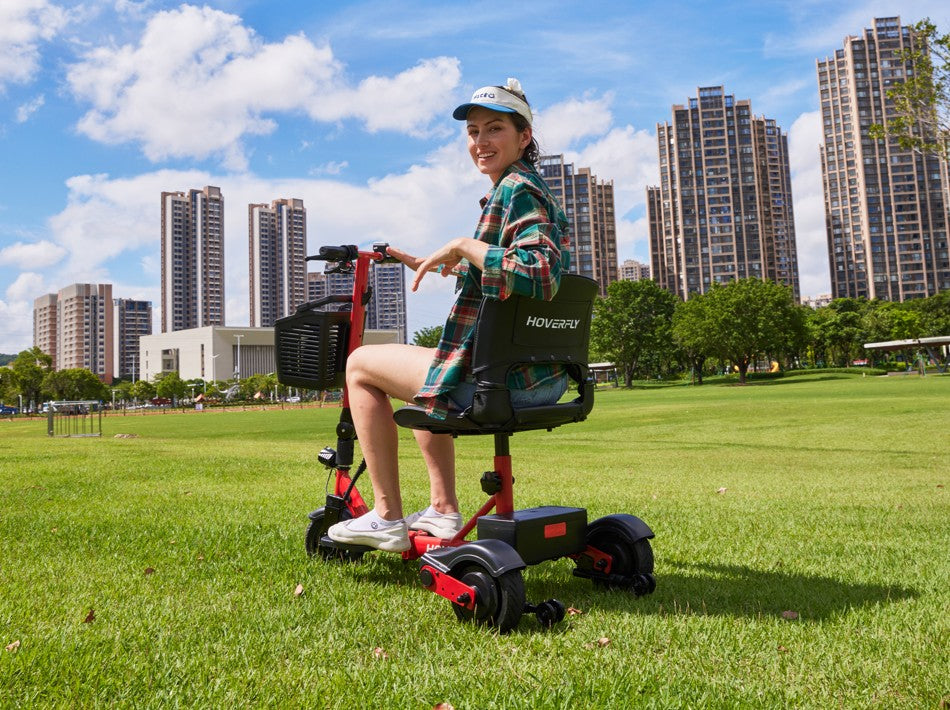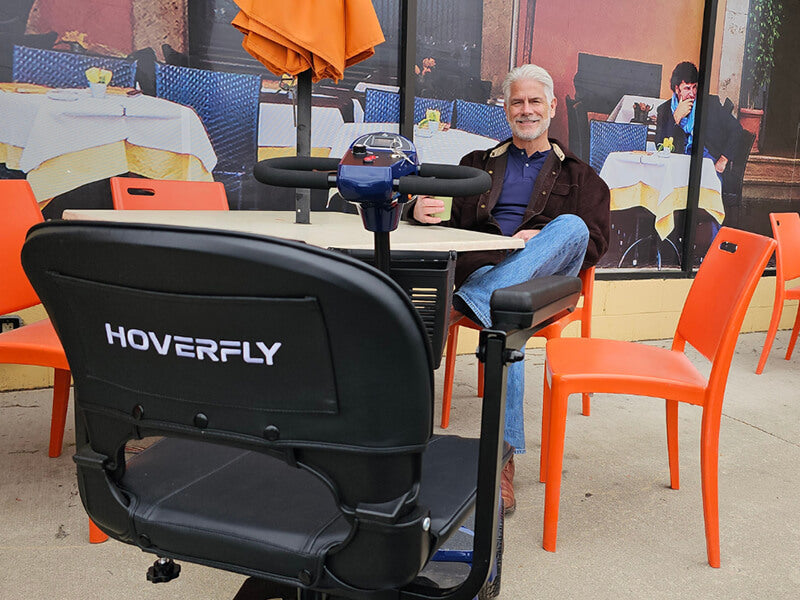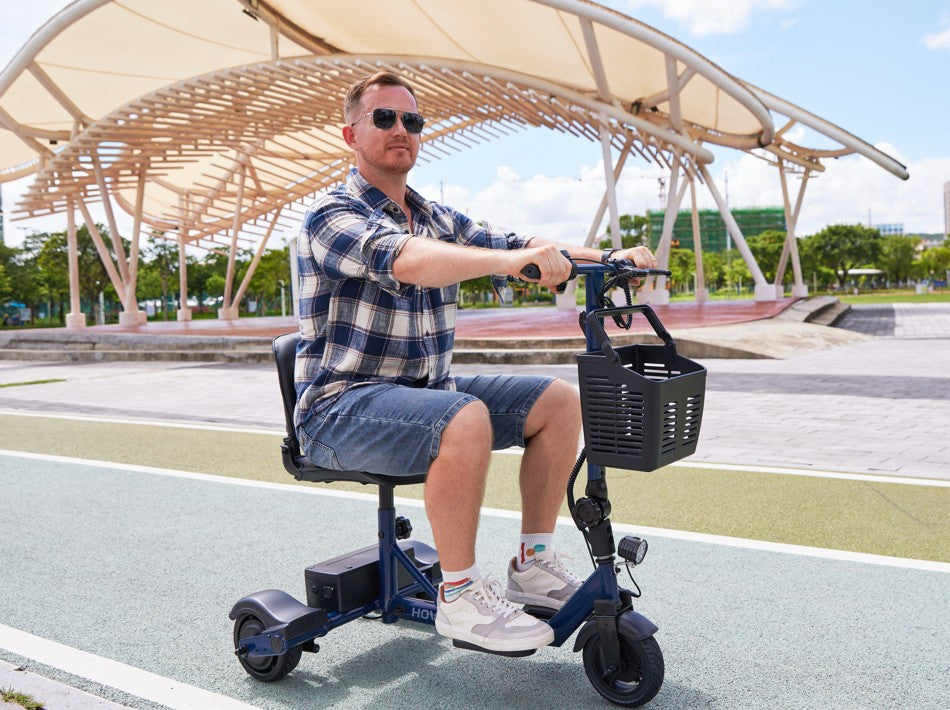Thinking about buying a mobility scooter or wondering how to maintain yours? This Mobility Scooter FAQ contains the most common questions about mobility scooters.
From getting to know the basics and how they work to keeping them well, you can find the right answer.
Mobility Scooter Basics
1. What is a mobility scooter?
A mobility scooter is an electric transporter for individuals as a mobility assistance device. It's often used as an alternative or complement to an electric wheelchair.
Usually, a standard mobility scooter has a seat, a flat platform for the feet, and handlebars or a tiller to provide steering. They are powered by rechargeable batteries and come in various sizes and types, from portable models to heavy-duty ones.

2. Is a mobility scooter a wheel chair?
No. One of the primary differences between a mobility scooter and a wheelchair lies in their operation.
Mobility scooters are controlled with a tiller and handlebars, while power wheelchairs are controlled with a joystick. Mobility scooters also typically have three or four wheels, whereas wheelchairs often have four or six for increased stability.
Another important distinction is the wheel setup. 3 wheel mobility scooters are more compact and feature a tighter turning radius, so they are extremely maneuverable indoors.
4 wheel mobility scooters have a broader wheelbase for better stability, so they tend to be popular for outdoor use and on rough terrain.
3. What are the different types of mobility scooters?
Folding Mobility Scooter: Folding mobility scooters are there for those seeking a mobility solution that offers a balance between usability and functionality. They are compact and portable, with a collapsible frame that can be quickly folded to fit in a car or onto public transport.
Standard Mobility Scooter: Need a more robust option for everyday use? The full-size or standard mobility scooter offers more comfort and features. Although they may not be foldable, they can still be disassembled into lighter parts.
Heavy-Duty Mobility Scooter: It is built for power and stability and is ideal for traveling on various terrains. With features like fat tires, suspension, and powerful motors, this type of mobility scooter provides a comfortable and secure ride for outdoor use and higher weight capacities.
4. Can I travel with my mobility scooter?
Yes, you can travel with a mobility scooter. For air travel, the U.S. airlines must transport your scooter at no charge under the Air Carrier Access Act.
Tip: Lithium-ion batteries in mobility scooters are subject to specific regulations and often need to be under a certain watt-hour rating. They possibly need to be removed and carried onboard.
When using public transportation like trains and buses, always check the specific policies. Many scooters are accessible, but they must meet size and weight limits.
Transporting a scooter in a personal car needs to be sure of the scooter's size and your vehicle's capabilities.
- Disassembly: For lightweight or folding scooters, the quickest way is to disassemble them into smaller parts to store in the trunk or back seat.
- Ramps: If you have an SUV, van, or any other vehicle with a large cargo area, you can drive the scooter up ramps and secure it inside with tie-down straps.
- Vehicle Lifts: For heavier scooters or for those unable to lift, a vehicle lift is the safest solution.
5. How much does a mobility scooter weigh?
A mobility scooter's weight is a factor that determines portability and varies by type. The weight of a mobility scooter also depends on the frame material, the battery type, and additional features like suspension and larger seats.
- Travel, foldable mobility scooters can weigh as little as 55-100 pounds.
- Mid-range mobility scooters typically fall between 100-220 pounds.
- Heavy-duty and high-performance scooters weigh 220 pounds or more, with some weighing as much as 400 pounds.
6. How much is a mobility scooter?
The cost of a mobility scooter can vary widely. Generally, you can expect to pay for a new mobility scooter from $600 to $2,000. Heavy-duty, high-performance, or top-of-the-line models can even cost $3,000 or more.
Catch the chance of the Limited Time Discount to get an affordable Hoverfly mobility scooter! You can easily find a high-performance model for under $600.
Some insurance programs, like Medicare or Medicaid, will cover part of the expense if the scooter is medically necessary.

Mobility Scooter Performance & Operation
1. How fast can a mobility scooter go?
The speed of the mobility scooter varies mostly depending on the model and application.
Most mobility scooters are designed to travel at walking speed, around 4 mph (6 km/h). Road-legal scooters (or Class 3 scooters) can travel up to 8 mph (13 km/h).
There are quicker models traveling up to 20 mph (32 km/h), though these are probably going to have certain conditions and must be registered.
As for road use, most mobility scooters are legally classified as pedestrian devices. They can be used on sidewalks, parking lots, and crosswalks, but on public roads, they are often restricted.
Tip: In some regions, road-legal mobility scooters may be required to have safety features. It is worth checking your local Department of Transportation (DOT) or municipal regulations.
2. How far can a mobility scooter go on a full charge?

The typical range is between 12 and 25 miles. This can be influenced by several factors:
- Battery size: The bigger the battery, the higher the range.
- Terrain: Going on hills or rough ground will drain the battery faster than on flat, smooth ground.
- Rider weight: The heavier the user, the reduced range of the mobility scooter.
- Driving speed: Driving at maximum speed will burn more power than driving at a moderate pace.
3. How often should I recharge the battery?
It is generally recommended to charge your mobility scooter batteries every time you have used them, even after a short ride. This keeps the battery healthy.
If you don't use it too often, charge it once a week to prevent draining the battery entirely. Avoid letting the battery to the 20% level since this reduces its lifespan.
If you plan to be away for a certain period, charge the scooter battery to about 80% and you can leave it for around two weeks. Once you return, charge it immediately, which helps maintain battery health.
Mobility Scooter Maintenance & Troubleshooting
1. How to maintain your mobility scooter?
Here are some key tips for you:
- Frequent Cleaning: Keep the scooter clean from dust and dirt. Keep an eye on cleaning the pivot parts and battery. Wipe it with a moist cloth, and ensure the mobility scooter is turned off while cleaning.
- Battery Maintenance: Follow the charging guidelines to keep healthy batteries.
- Tire Pressure: Regularly check tire pressure and inflate them to the recommended levels.
- Regular Checks: Look for any wear signs, such as worn tires, cable wear, or loose parts.
- Professional Service: Schedule an annual service check-up by a trained technician.
Learn how to inspect controller wiring on a mobility scooter (take Hoverfly T4 Electric 4-wheel Mobility Scooter as an example).
2. How to replace a battery in a mobility scooter?
You are able to change a mobility scooter battery at home, but you have to be cautious. The process is the following:
- Turn off the scooter: Ensure the power is completely switched off and the charger unplugged.
- Locate the battery compartment: This is usually under the seat or in a designated battery box.
- Unplug the old batteries: Remove the negative terminal first with a wrench, followed by the positive terminal. Take a picture of the wiring so you can see how to hook up the new batteries.
- Install the new batteries: Place the new batteries in the compartment and connect the positive terminal first, then the negative terminal.
- Test: Quickly test the mobility scooter before closing the compartment to ensure that it is functioning correctly.
Learn how to replace a battery in a mobility scooter (take Hoverfly T3 3-wheel Foldable Mobility Scooter as an example).
3. What is the most common problem with mobility scooters?
The most common problem with mobility scooters is battery problems. Batteries will naturally lose their ability to hold a charge as time passes.
Some other common problems are:
- Motor problems: Older models may develop flat spots in the motor, which leads to a harsh ride.
- Tire troubles: Worn tires or underinflated tires affect performance and stability.
- Faulty components: Components like the throttle potentiometer may fail because of corrosion or wear.
Tip: Regular maintenance and taking care of batteries are the best ways to prevent many of these common problems.
We hope this guide has addressed your concerns and offered insight into the mobility scooter world.
If you're considering a purchase, Contact Us to ensure you choose the best model for your specific needs. Stay safe and mobile! Or call us 1-326-600-3589.




Leave a comment
All comments are moderated before being published.
This site is protected by hCaptcha and the hCaptcha Privacy Policy and Terms of Service apply.